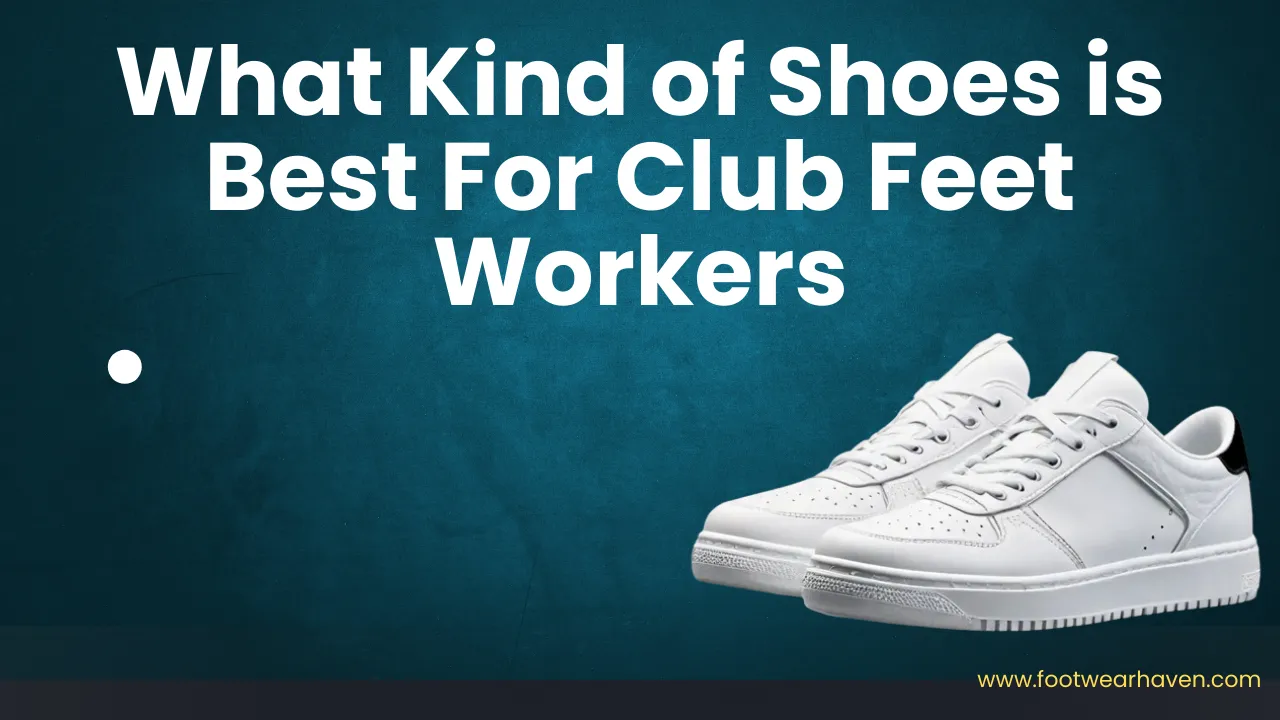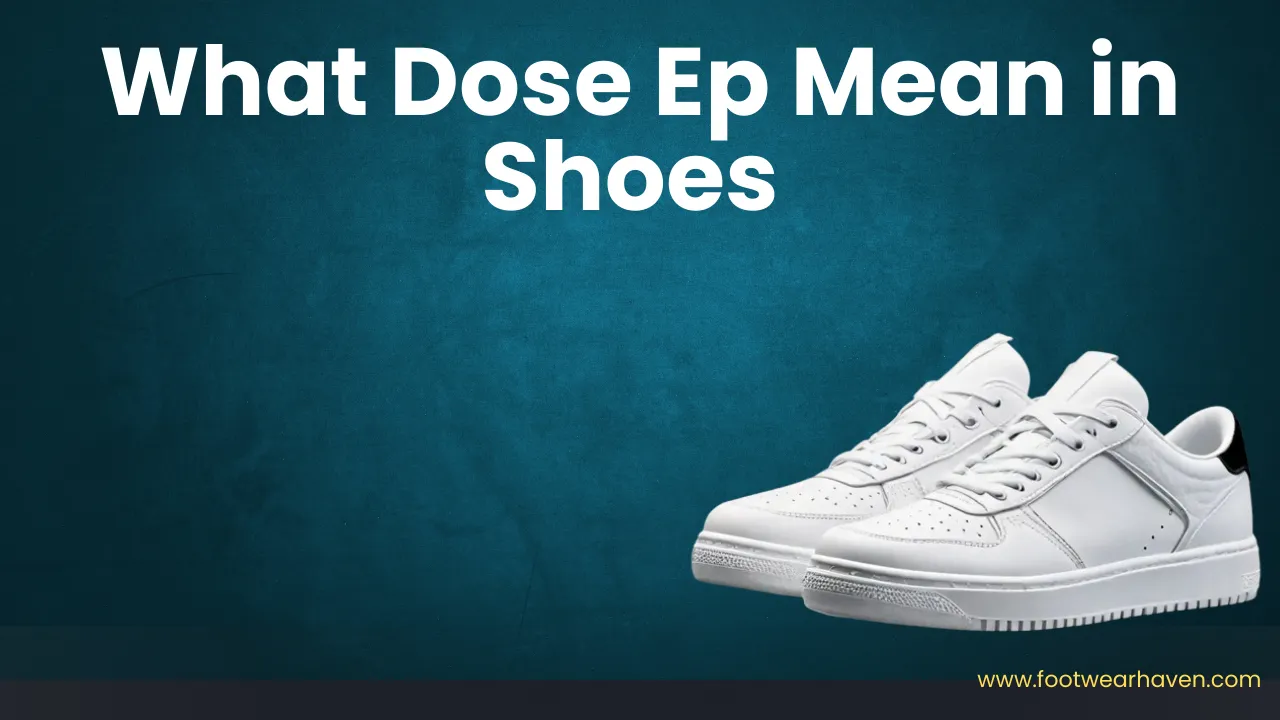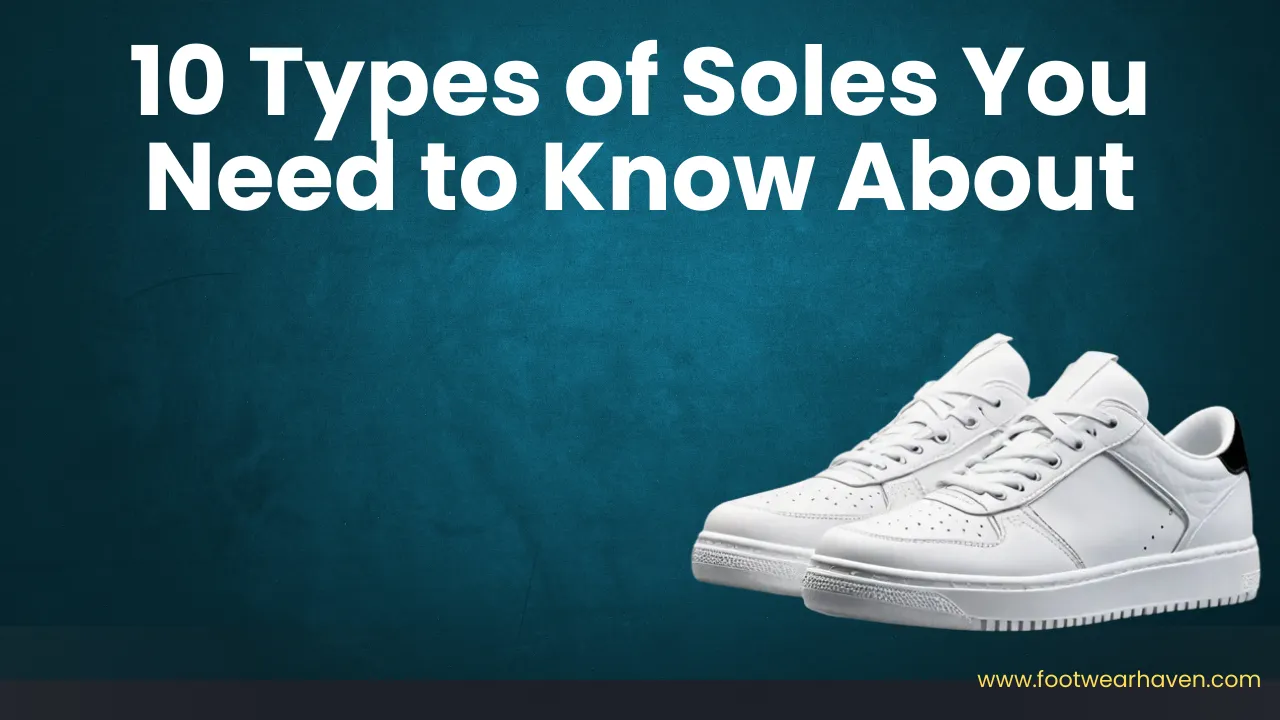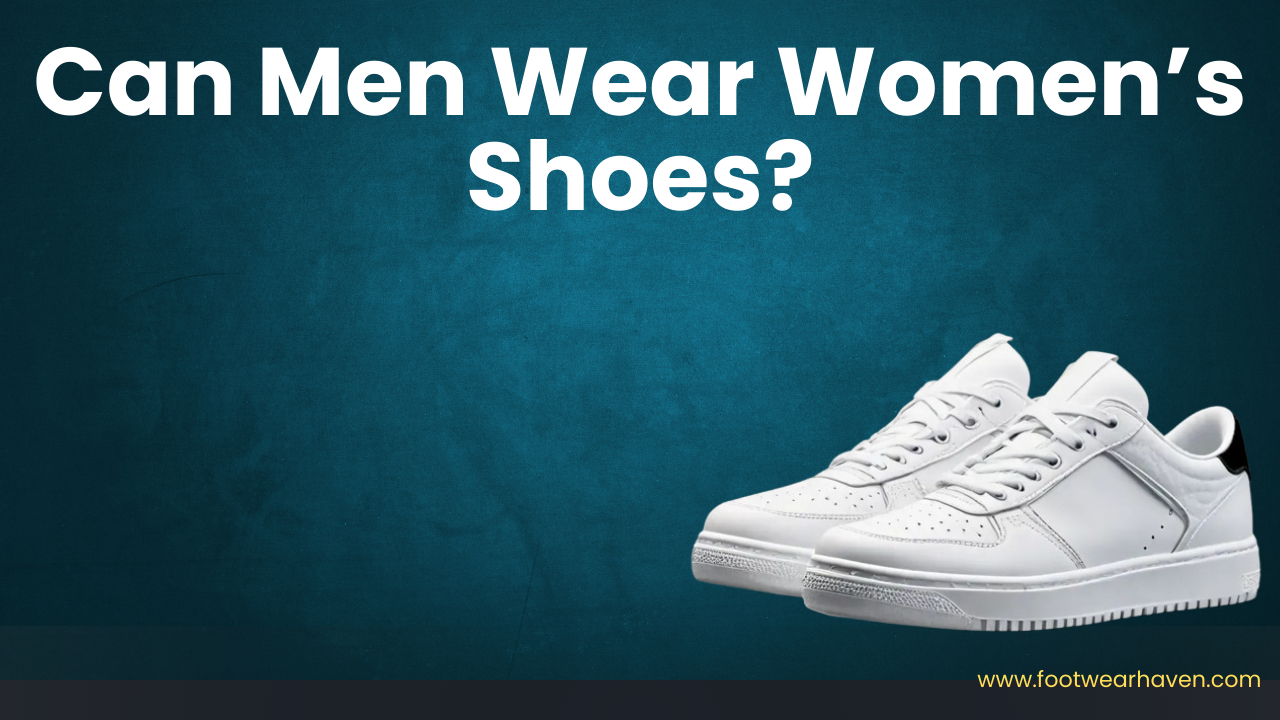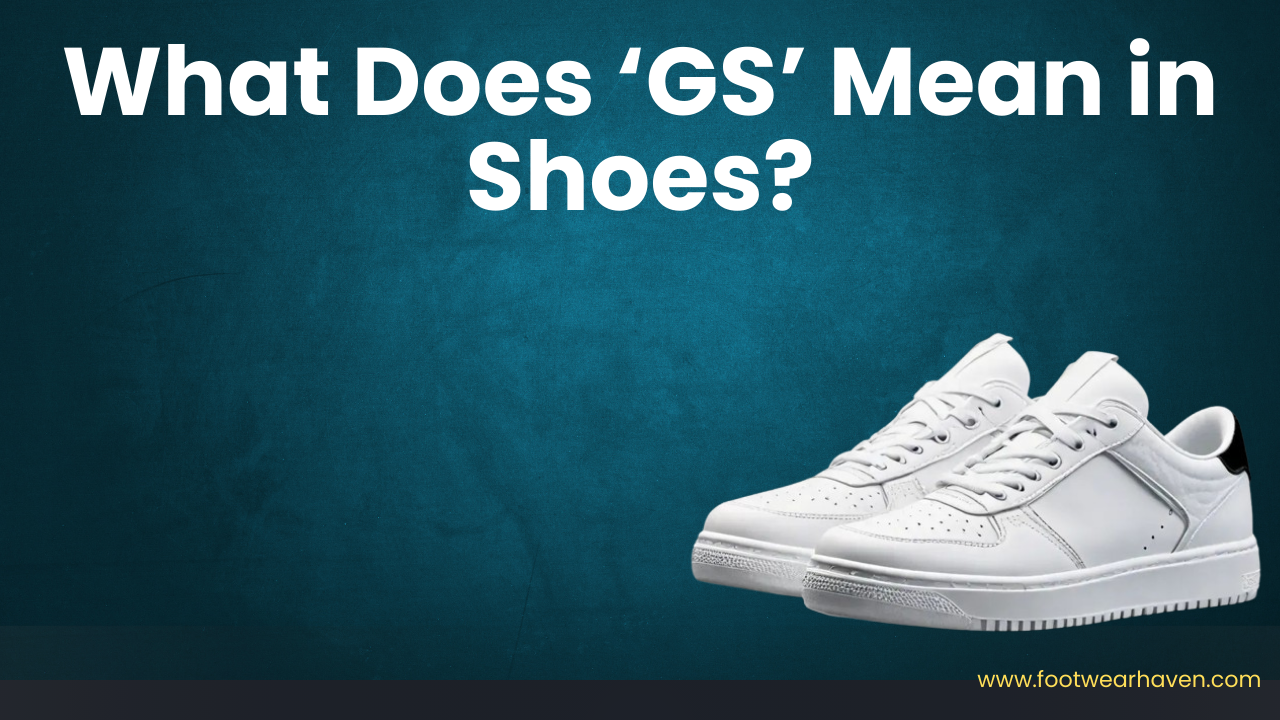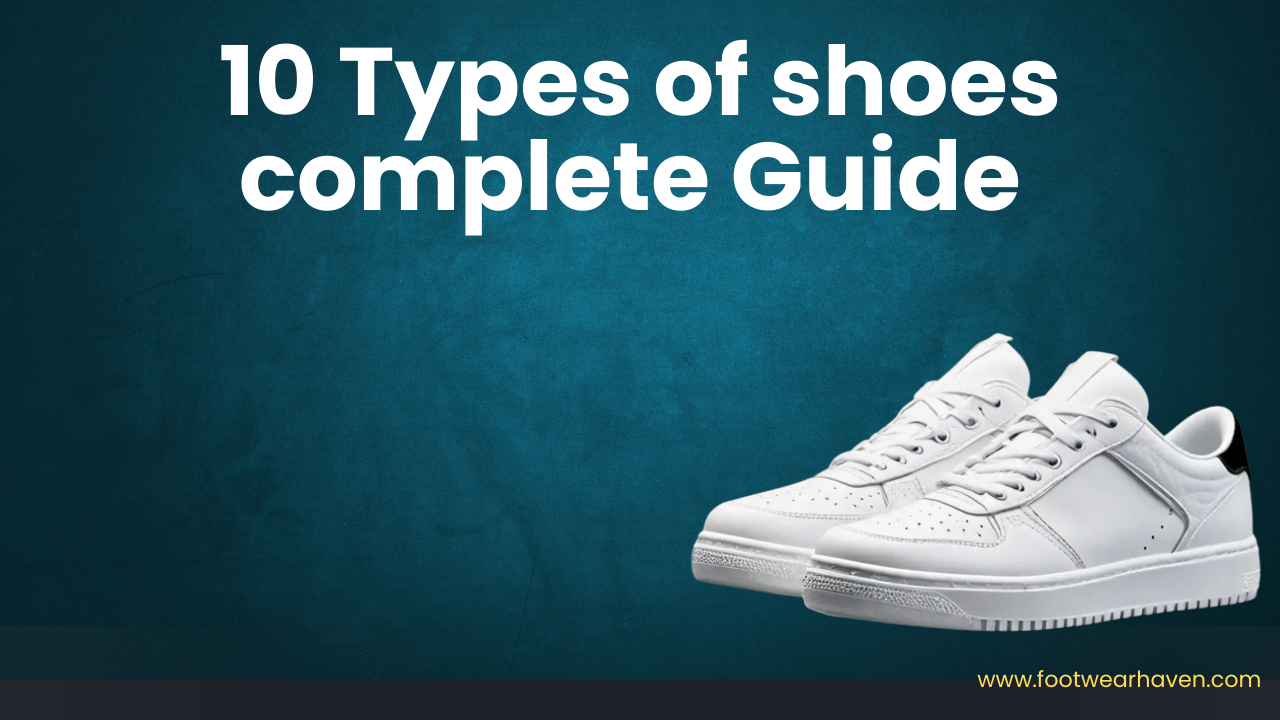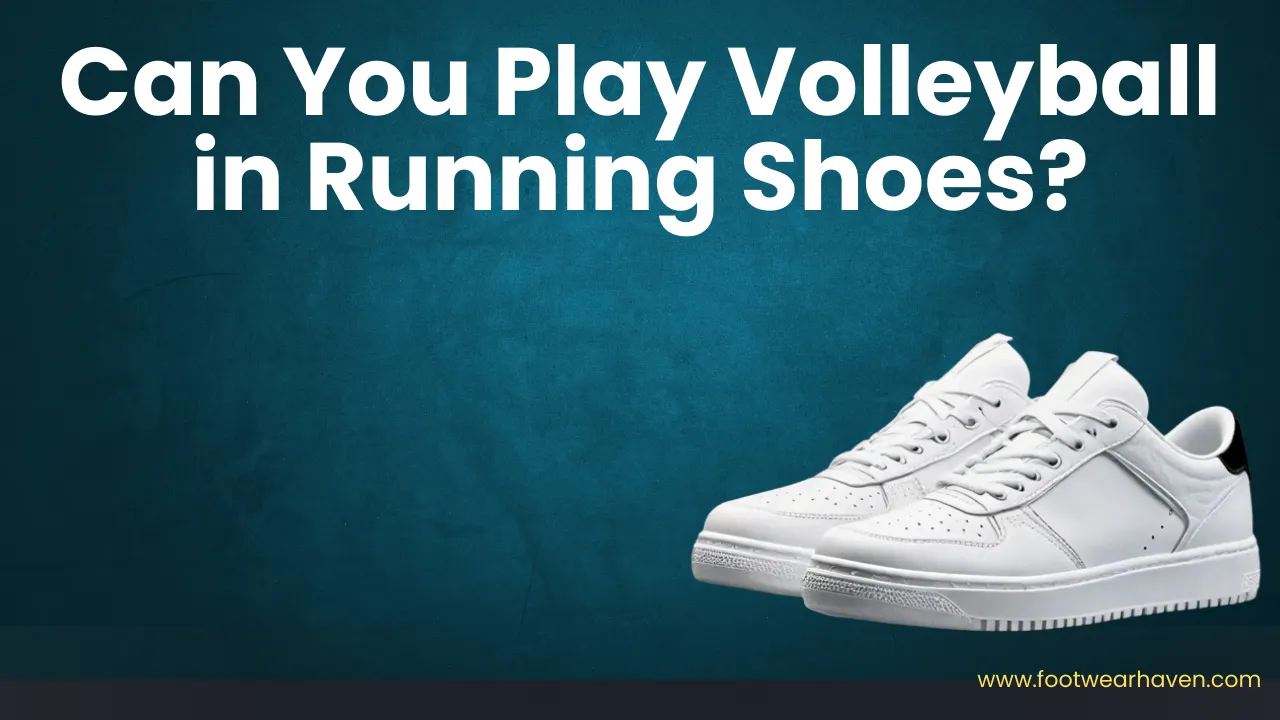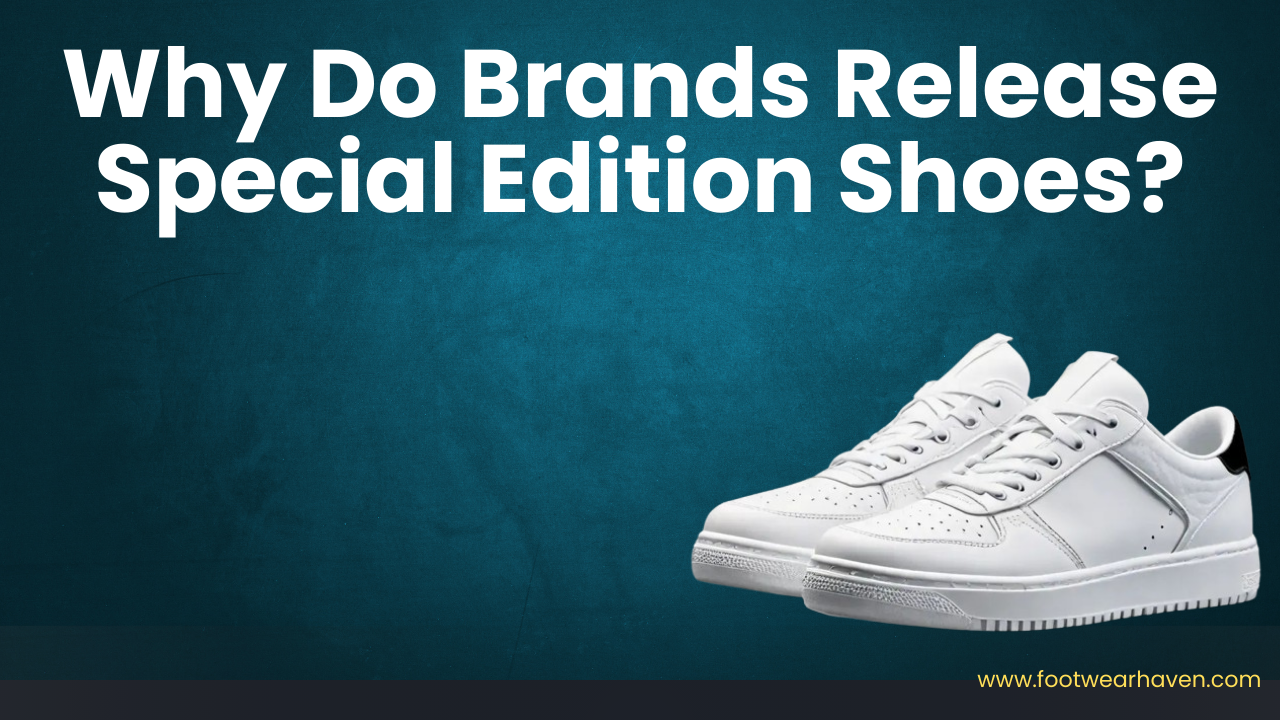Finding the right shoes for club feet workers is essential for reducing pain, preventing fatigue, and improving mobility during long hours on the job. Since regular footwear often fails to support unique foot structures, workers with club feet need shoes that offer extra arch support, wide toe boxes, and stability features. The right choice not only ensures comfort but also helps protect against long-term joint stress, making specialized footwear a must for anyone with club feet who works on their feet daily. Key Factors for Choosing Shoes for Clubfoot Workers Since the foot structure of individuals with club feet differs from the average, regular shoes often don’t fit well, causing discomfort. When selecting work shoes, you should focus on the following key factors to ensure comfort and support: 1. Arch Support People with club feet typically have higher arches. Without adequate support, extended walking or standing can overstretch the foot muscles, leading to pain and strain. Shoes with enhanced arch support help alleviate pressure on the arch and reduce discomfort. 2. Wide Toe Box Club feet often cause inwardly rotated forefeet, so having a wide toe box is essential. This extra space prevents friction and reduces pressure on the toes, making the shoe more comfortable to wear throughout the day. 3. Removable Insoles Many individuals with club feet use custom orthotics to correct their gait, especially workers who are on their feet for long periods. Shoes with removable insoles allow space for thicker orthotic inserts, providing better customization for foot health. 4. Stability & Slip Resistance For manual laborers, balance is crucial. Choose shoes with a sturdy heel and stable sole. Additionally, opt for shoes with slip-resistant outsoles to ensure grip on slippery surfaces, reducing the risk of injury. Best Shoes for Workers with Club Feet 1. Orthopedic Work Shoes For workers in industrial or physically demanding jobs, orthopedic work shoes are ideal. These shoes offer enhanced arch support and a high-top design to stabilize the ankles, which is essential for individuals with club feet. Orthopedic work shoes not only protect your feet but also ensure comfort during long shifts. 2. Arch Support Shoes Lighter in weight, arch support shoes provide excellent support. Their outsoles often feature shock-absorbing materials like EVA or memory foam, making them ideal for workers with club feet. These shoes are suitable for less physically demanding jobs, such as office or warehouse environments. 3. Custom Orthopedic Shoes Custom orthopedic shoes are specifically designed for your unique foot structure. They offer customizable arch support, insole thickness, and heel height. Although more expensive, these shoes provide the most personalized comfort and support, especially for severe cases of club feet. Tips for Finding the Best Shoes for Club Feet With so many options on the market, it can be challenging to determine which shoes will work best for club feet. The following tips will help you make the right choice: 1. Look for Specialized Orthopedic Shoe Brands Brands like Orthofeet, Dr. Comfort, and Aetrex specialize in shoes for foot deformities. These shoes often feature arch support, wide lasts, and heel cushioning, making them suitable for individuals with mild to moderate club feet. 2. Consult a Podiatrist or Orthotist An orthopedic surgeon is measuring the foot data for a patient For professional advice, consult a podiatrist or orthotist. They can provide recommendations on shoe brands and types of support based on a thorough foot assessment. In some cases, they can prescribe orthopedic shoes, which may qualify for partial insurance coverage. 3. Online Customization Platforms Platforms like Crispin Orthotics and Surestep offer online customization services. They use detailed foot measurements to create custom shoes, making them an excellent option for individuals with more severe foot deformities. 4. Choose Shoes with Removable Insoles Some regular shoes with removable insoles, like the New Balance 928v3 and Brooks Addiction Walker 2, can accommodate orthotic inserts. These shoes provide excellent support for people with club feet, making them another good option. FQAs (Frequently Asked Questions) Should workers with club feet use custom orthotics? Custom orthotics are highly recommended, especially for workers who stand or walk all day. They provide personalized support that regular shoes cannot. What features should I look for in shoes for club feet workers? Key features include strong arch support, wide toe boxes, removable insoles (for orthotics), slip resistance, and durable cushioning. Are there brands that specialize in shoes for club feet? Yes, brands like Orthofeet, Dr. Comfort, Aetrex, and custom providers like Surestep and Crispin Orthotics specialize in footwear for unique foot conditions. Final Words The right work shoes can significantly improve comfort and mobility for workers with club feet. Whether you’re looking for orthopedic work shoes or customizable options, it’s essential to choose shoes based on your specific needs. We hope this guide has helped you identify the best shoes for club feet. For more expert tips, stay tuned for our latest updates!
What Does EP Mean In Shoes?
If you’ve ever wondered what EP mean in shoes, it stands for Engineered Performance — a label that highlights footwear built with premium materials and advanced design for better comfort, traction, and durability. In simple terms, EP in shoes means the pair is optimised for athletic performance, offering superior cushioning and long-lasting support whether you’re running, training, or playing sports. Defining the Meaning of EP in Shoes The term “EP” on some shoes might have left you curious. EP stands for Engineered Performance in the shoe industry. This label signifies that these shoes are constructed using advanced materials and modern technologies aimed at optimizing performance, especially for sports or high-intensity activities. Benefits of EP in Shoes 1. Revolutionary Design EP shoes go beyond regular footwear. They are expertly crafted to provide maximum comfort, support, and a sleek design. With an emphasis on functionality, EP shoes often feature ergonomic structures, superior support, and enhanced responsiveness to provide a top-notch experience. 2. Advanced Materials EP footwear typically incorporates cutting-edge materials suited for various activities. These materials often include shock-absorbing soles, breathable fabrics, and cushioned midsoles, all designed to help you perform at your best during different activities. 3. Improved Performance When wearing EP shoes, you’re equipped with footwear engineered to boost your performance. Whether you’re running, working out, or engaging in sports, EP shoes deliver superior support, flexibility, and cushioning, ensuring you stay comfortable and focused. 4. Longevity and Durability EP shoes are designed to last, thanks to the durable materials and innovative construction techniques. Even with frequent wear, these shoes offer long-lasting performance, ensuring that they remain reliable over time. Types of EP Components Breathable Uppers: Keep feet cool and comfortable during activity. Responsive Outsoles: Improve traction and grip on various surfaces. Advanced Midsoles: Provide cushioning and absorb impact for better comfort. Durable Rubber Outsoles: Made from solid or transparent rubber for superior support and wear resistance. End Price Strip: Extends from toe to heel to enhance durability and structure—an old shoemaking feature. Cushioning Technology: Modern tech (like Nike Shox) improves comfort and performance. Wider Fit Design: Offers more room for different foot shapes, ensuring comfort in high-impact movements. Brands Using EP Technologies 1. Under Armour Under Armour’s HOVR Havoc EP and Curry 7 EP are prime examples of EP shoes. Known for their sleek design, these models offer excellent support and traction, making them ideal for individuals seeking agility and speed. 2. Nike Nike is one of the leading brands utilizing EP technology. In the early 2000s, they introduced EP rubber (ethylene propylene diene monomer) in their Shox series. This synthetic rubber is lightweight, durable, and resistant to abrasion, making it perfect for shoes’ soles and midsoles. Over time, many other top brands have developed their own versions of EP technology, each focusing on improving specific aspects of performance like durability, grip, and cushioning. 3. Adidas Adidas’s Dame 6 and Dame 4 EP are standout EP shoes, well-regarded for their sturdy construction and responsive cushioning. 4. Puma Puma’s Clyde Hardwood EP sneakers offer an innovative design combined with top-tier performance. Their responsive cushioning and durable outsole provide excellent traction, ideal for sports activities. How Do You Know If a Shoe Is EP? Identifying EP shoes can be tricky since different brands use various terms to describe their unique models. However, there are some clues. Many brands prominently label their shoes as “EP” on the packaging or product descriptions, especially for performance-enhancing basketball shoes. You can also look for distinguishing design features, such as thicker soles, enhanced heel and forefoot cushioning, and durable materials. While the term “EP” may not be universal, brands like Under Armour and Adidas have alternative names for their performance-enhancing technology, such as HOVR for Under Armour or Boost for Adidas. How Do the EP Version of Shoes Affect the Price? EP shoes generally come with a higher price tag than regular versions because of the premium materials and advanced technologies used. However, their durability and improved performance make the investment worthwhile in the long run. FQAs (Frequently Asked Questions) What is the difference between EP and regular shoes? EP shoes use enhanced materials and construction for improved performance, while regular shoes focus more on style or casual wear. Are EP shoes good for sports? Yes, EP shoes are made for high-performance activities like running, training, and basketball, offering better grip and cushioning. Why are EP shoes more expensive? They cost more due to premium materials, advanced technology, and durable construction that ensure longer-lasting performance. How can I tell if my shoes are EP? Check the product label or description—EP shoes are often marked with “EP” and include thicker soles, durable outsoles, and advanced cushioning. Final Words EP technology brings a unique blend of lightweight durability to the shoe world. While slightly more expensive than other materials like leather, EP shoes offer an excellent balance of performance and value for athletes and active individuals. We hope this guide has clarified the significance of EP in footwear and provided you with the insights needed to choose the best EP shoes for your needs.
Can You Put Shoes in the Dryer? Here’s What You Need to Know
Putting shoes in the dryer can be safe if done correctly, but not all shoes can handle the heat. When you put shoes in the dryer, materials like leather, suede, or glued soles may get damaged or lose their shape, while canvas or running shoes usually dry well on a low-heat setting. Using a mesh laundry bag or pillowcase with towels helps reduce noise and protect both your shoes and the dryer. Still, air drying or using a fan remains the safest method to keep your footwear in good condition. Understanding the Risks of Drying Shoes in a Dryer 1. Heat Damage Most shoes aren’t built to withstand the high heat of a dryer. Materials like leather, suede, and certain synthetic fabrics can warp, shrink, or even melt under extreme temperatures. 2. Shape Deformation The shape of your shoes often determines their comfort and support. The tumbling motion in the dryer can cause rubber or foam soles to lose their shape, impacting how they fit and feel. 3. Noise and Potential Dryer Damage Ever tossed shoes in a dryer and heard that annoying thudding noise? The sound of shoes bouncing around inside is not only loud but could also damage the dryer drum. Types of Shoes You Should Never Put in the Dryer How to Dry Shoes in a Dryer Safely If you decide to use a dryer, follow these steps to protect both your shoes and the appliance: Alternative Ways to Dry Your Shoes If using a dryer feels too risky, there are safer alternatives that work just as well: 1. Air Drying Remove the laces and insoles, then stuff your shoes with paper towels or newspaper. Place them in a well-ventilated area. Change the paper once it’s saturated, and you’ll be surprised at how quickly your shoes dry. 2. Using a Fan Position your shoes in front of a fan to speed up the drying process without using heat. This method works well and avoids any risk of heat damage. 3. Specialized Shoe Dryers Shoe dryers are designed specifically for drying shoes. They use a consistent airflow at low temperatures, making them a safer option for most materials. How to Dry Shoes with Newspapers Drying shoes with newspapers is a tried-and-true method. Begin by removing the laces and insoles to promote ventilation. Next, grab some black-and-white newspaper (avoid color ink to prevent staining), crumple it, and stuff it inside the shoes, especially in the toe area where moisture tends to accumulate. For extra absorption, wrap more newspaper around the exterior of the shoes. Keep your shoes away from direct heat sources, and place them in a dry, well-ventilated spot. The shoes should be dry in a few hours, or by the next morning. Remember to check and replace the newspaper regularly if it gets damp. This method is gentle on your shoes and helps keep them fresh and odor-free. FQAs (Frequently Asked Questions) What dryer setting is best for shoes? Use the lowest or no-heat setting to protect the material. High temperatures can shrink soles, melt glue, and permanently ruin your shoes. How long should shoes stay in the dryer? Keep shoes in the dryer for about 20–30 minutes on low heat. Check halfway through to prevent overheating or damage to the shape. What’s the best alternative to a dryer? Air drying in a ventilated area or using a fan is the safest method. You can also stuff shoes with newspaper to speed up moisture absorption. Can I dry shoes in a pillowcase? Yes, place them in a pillowcase or mesh bag with towels. It minimizes thudding sounds and protects both your shoes and the dryer drum. Final Words While some types of shoes can safely go in the dryer, it’s essential to exercise caution. Air drying is generally the safer choice and can help extend the life of your shoes. However, in urgent situations, following the right steps can protect both your footwear and your dryer.
10 Types of Soles You Need to Know About
Understanding the different types of soles is crucial when selecting shoes that cater to your comfort, durability, and performance requirements. From leather and rubber to modern materials like EVA and TPU, each sole type offers unique benefits for specific uses. Additionally, innovations such as EP in shoes (Engineered Performance) have transformed how soles are designed, offering better traction, flexibility, and long-term support. This guide breaks down the most common sole types to help you make the right footwear choice for your lifestyle or activity. 10 Different Types of Soles Used in Shoes Below are the 10 most common types of soles used in footwear today. Each material offers distinct advantages in terms of durability, comfort, and purpose—helping you choose the right pair for your needs. 1. Genuine Leather Shoe Soles Genuine leather, derived from animal hide through tanning, is a premium material commonly found in dress shoes, high-end casual shoes, and leather boots. Features Drawbacks Genuine leather is a high-cost material that requires regular maintenance. It is also unsuitable for wet conditions. 2. PU Shoe Soles PU, or polyurethane, is a synthetic material known for its durability and abrasion resistance, making it ideal for work shoes and boots. Features Drawbacks The production process of PU is labor-intensive, making it pricier. It also offers limited breathability, leading to reduced comfort for prolonged wear. 3. PVC Shoe Soles PVC, a polymer obtained from vinyl chloride, is often used for rain boots, work shoes, and budget fashion shoes due to its low cost and mass production suitability. Features Drawbacks PVC has poor slip resistance, posing a safety risk in high-friction areas. It is also hard, lacks breathability, and becomes brittle in cold weather. 4. Artificial Leather Shoe Soles Artificial leather, made by synthesizing PVC and PU, mimics natural leather. It’s often used in fashion shoes, sneakers, and budget-friendly footwear. Features Drawbacks Artificial leather is less breathable and durable than real leather, making it harder and less comfortable over time. 5. Rubber Shoe Soles Rubber is a polymer material classified into natural rubber and synthetic rubber. It’s widely used in sports shoes, hiking boots, and work shoes due to its elasticity and durability. Features Drawbacks Despite its durability, rubber is heavy and lacks breathability. It can also harden in colder temperatures. 6. EVA Shoe Soles EVA is a lightweight material with cushioning properties, making it popular in sports shoes, sandals, and outdoor footwear. Features Drawbacks EVA wears out over time, lacks repairability, and offers poor heat resistance, making it unsuitable for long-term use. 7. MD Shoe Soles MD is a lightweight material created by modifying the density of EVA through a secondary foaming process. It’s commonly used in casual and sports shoes for its slip resistance and comfort. Features Drawbacks MD’s softness means it provides less support, making it unsuitable for high-support footwear like hiking boots. It also has poor heat resistance and a higher production cost. 8. TPR Shoe Soles TPR is made by blending rubber and plastic, offering the elasticity of rubber and the reprocessability of plastic. It’s commonly used in casual, running, and work shoes. Features Drawbacks While TPR has good chemical resistance, it falls short compared to rubber in harsher chemical environments. Its manufacturing process is complex, leading to higher costs. 9. TPU Shoe Soles TPU is a polymer known for its high elasticity and flexibility. It’s often used in sports, casual, and work shoes for its durability. Features Drawbacks TPU has a more complex manufacturing process and is pricier compared to other materials. 10. TR Shoe Soles TR combines plastic and rubber properties, offering the moldability of plastic and the elasticity of rubber. It’s popular in sports and children’s shoes. Features Drawbacks TR struggles with temperature extremes, deforming in heat and hardening in cold. It also doesn’t withstand strong acids or alkalis, limiting its use in extreme environments. 11. BPU Shoe Soles BPU is an eco-friendly polyurethane material made partly from renewable resources, reducing environmental impact. It’s often used in sports shoes, slippers, and casual footwear. Features Drawbacks BPU’s color stability and uniformity are hard to control, limiting color options. It’s also more expensive than EVA, despite being more environmentally friendly. FQAs (Frequently Asked Questions) Which type of sole is best for daily wear? Rubber and EVA soles are ideal for daily wear due to their flexibility, comfort, and shock absorption. Which sole lasts the longest? Rubber and TPU soles typically last the longest, offering high wear resistance and strong grip on various surfaces. Are leather soles better than rubber soles? Leather soles look more formal and breathable, while rubber soles are more durable, waterproof, and slip-resistant. What is the lightest sole material? EVA is one of the lightest sole materials, providing excellent cushioning and comfort for long hours of use. Which sole is best for sports shoes? TPU, MD, and EP-based soles are best for sports shoes due to their flexibility, traction, and energy return. Conclusion Selecting the right sole type can make a big difference in comfort, performance, and durability. Whether you prefer the natural feel of leather, the cushioning of EVA, or the high-tech support of EP in shoes, understanding each material helps you choose footwear that fits your needs perfectly.
Can Men Wear Women’s Shoes?
Reasons Men Wear Women’s Shoes 1. Enhanced Comfort & Better Fit Many men opt for women’s shoes due to their enhanced comfort. If you have smaller feet, it’s important to note that women’s shoes are often designed for narrower feet. Sports brands, in particular, produce women’s shoes using lightweight materials, offering a snug fit that might be ideal for men with similar preferences. 2. Style Variety Let’s be real: the men’s shoe section can sometimes feel limited in terms of design and creativity, especially when compared to women’s collections. Women’s shoes come in a wide range of colors, materials, and patterns, allowing for more options to express individuality. Learn More: Best Shoes for Greek Feet 3. Versatility in Function Whether you’re searching for lightweight running shoes or specialized boots, women’s shoes often provide a broader selection of styles. If you’re aiming for a specific height or heel style for a costume or event, women’s footwear usually offers more flexibility in this regard. 4. Cost-Effective Options When comparing similar designs, women’s shoes are sometimes priced lower than their men’s counterparts. Who wouldn’t want to enjoy a stylish pair of shoes at a more budget-friendly price? Styling Women’s Shoes for Men Once you’ve selected the right pair, it’s time to think about how to style them. Below are a few tips: Know More: Types of Shoes for Different Occasions Breaking Down Gender Stereotypes in Footwear If you’ve ever felt hesitant to try women’s shoes, remember that fashion doesn’t have strict rules. Both style and comfort can be found across all genders. Some women’s shoe designs may fit your preferences, offering sleek designs, vibrant colors, and unique styles that suit you perfectly. With fashion constantly evolving, unisex shoe designs are gaining popularity. Designers now integrate elements from both men’s and women’s collections, proving that many footwear differences are driven by marketing rather than necessity. How to Find the Right Fit To find the perfect fit when trying on women’s shoes, you’ll first need to figure out the size conversion between men’s and women’s footwear: Considerations When Finding the Right Women’s Shoes for Men 1. Sizing Differences Men’s and women’s shoe sizes vary, but finding the right fit is manageable. Always refer to size charts and guides provided by brands to understand their sizing system. Also, consider the width of your feet, as some men may find women’s shoes with a slightly larger size to be a better fit. Testing different styles is the key to finding the right fit. Read Also : Td Mean in shoe size Learn More: How Often Should You Change Barefoot Shoes? 2. Try Different Styles Don’t hesitate to experiment with various designs and sizes to find the best match. By trying on multiple shoes, you can learn more about your foot’s width, shape, and arch, helping you choose shoes that provide maximum comfort and support. Finding the perfect pair might take time, so remain persistent. Time to Consider Your Overall Style When choosing women’s shoes, it’s crucial to consider how they will fit into your overall look. Think about the colors, materials, and styles you typically wear. If you prefer a laid-back style, opt for sneakers or loafers. For a more formal look, consider dress shoes or boots. Remember to consider the occasion and the image you want to project. Selecting the right footwear can help you exude style and confidence. Heva Shoes offers a wide selection of trendy and comfortable women’s shoes that cater to diverse tastes and needs. With user-friendly designs and a focus on comfort, they are the go-to choice for those who want to showcase their style through footwear. Get in touch with us today!
What Does ‘GS’ Mean in Shoes
‘GS’ stands for ‘Grade School,’ referring to a size range mainly designed for older kids and youth. Nike popularized the term ‘GS’ in the 1990s to early 2000s as they sought to capture the growing youth market through targeted branding. What age group is the ‘GS’ size suitable for? GS sizes cater to school-age children, typically between 6 and 12 years old, ranging from 3.5Y to 7Y. It’s also worth mentioning that in addition to GS, brands offer PS (Preschool) and TD (Toddler) sizes. Given that foot shape and development vary with age, offering specific sizing is crucial to meet diverse needs. I’ve also explained these other sizes in another blog post. If you’re interested, check out Can adults wear GS-sized shoes? Even though GS sizes are created for kids, adults can still wear them. GS sizes cover 3.5Y to 7Y, where 7Y is approximately equivalent to a men’s US size 7 or a women’s US size 8.5. GS sizes are ideal for adults with smaller feet, especially women. In fact, GS sizes are often considered women’s sizing by default. GS Size Adult Size (US Men) Adult Size (US Women) Insole Length (Inches) 3.5Y 3.5 5 8.86 4Y 4 5.5 9.06 4.5Y 4.5 6 9.25 5Y 5 6.5 9.37 5.5Y 5.5 7 9.49 6Y 6 7.5 9.65 6.5Y 6.5 8 9.84 7Y 7 8.5 10.04 GS Size Chart – Please refer to each brand’s official size chart for accurate sizing. Differences Between GS Shoes and Adult Shoes Price Difference GS-sized shoes are typically more affordable than their adult counterparts. For example, a US 7 Jordan 1 Mid Banned (2020) is priced at $119 on StockX, while the same shoe in a GS US 7Y is only $60. Even though the appearance of GS and adult sizes may be similar, GS shoes are often priced at half the cost. If you have smaller feet, GS sizes can be a great bargain. Size Difference While GS sizes correlate with men’s sizing, there is a 1.5-size difference between men’s and women’s shoe sizes. For women, you’ll need to choose a GS size that is 1.5 sizes smaller than your usual women’s size. Configuration Differences GS shoes are essentially lower-spec versions of adult shoes. For example, the adult Jordan 13 has Zoom Air cushioning in both the forefoot and heel, as well as a carbon fiber plate in the sole for added stability. In contrast, the GS version only features heel cushioning, and the sole uses TPU instead of a carbon fiber plate. While GS shoes are perfect for everyday casual wear for adults with smaller feet, their durability and material strength may not hold up to intense sports activities. How to Choose the Right GS Size for Your Child Read Also : Ep Mean in shoes Before purchasing, it’s important to measure your child’s foot size and compare it with the brand’s size chart. Here’s a simple guide: Prepare the Tools Measurement Process Place the paper on a flat surface with one edge against the wall. Have your child stand with their heel touching the wall, then trace the outline of their foot. Use a ruler to measure the length and width. Size Comparison When selecting a size, it’s a good idea to add 0.5 to 1 cm to the foot’s length to allow for growth. Additionally, since children’s foot structures grow slower at school age, I recommend re-measuring their size every 3-6 months to avoid discomfort or issues with foot development. Final Words With the expansion of the sneaker market, GS sizes have become a key player. Whether you’re looking for the perfect shoes for your child or a budget-friendly option for yourself, GS sizes offer great value. I hope this article has clarified what ‘GS’ means and provided helpful insights into shoe sizing for both kids and adults.
10 Types of shoes
Athletic Shoes Athletic shoes are specifically designed for a variety of physical activities and sports. They provide the necessary support and protection to keep your feet safe during exercise or gameplay. Below are some common types of athletic shoes: Running Shoes Running shoes are built to help you run effortlessly and securely. They’re particularly renowned for boosting the performance of runners, both amateur and professional. The midsole typically consists of Ethylene Vinyl Acetate (EVA) for enhanced cushioning and Polyurethane (PU) for durability. The outsole, which makes contact with the ground, is crafted from tire-grade rubber to ensure traction on most surfaces. The upper part, made of engineered mesh, covers the top and sides of the shoe, allowing breathability during runs. Some variants have knit uppers that offer a snug fit but may compromise ventilation. Keep in mind that cushioned shoes can cause biomechanical alterations in your body. According to a 2018 study, running shoes can also increase leg stiffness and the impact on feet, potentially affecting your body’s natural spring-like mechanics and raising the risk of injury. Training Shoes Training shoes, also known as trainers, are more specialized compared to regular athletic shoes. While running shoes cushion forward movements, training shoes are optimized for lateral movements and high-intensity exercises. Although they are made from similar materials as running shoes, trainers often feature synthetic mesh. While not as durable, this mesh supports dynamic movements during exercises. These are ideal for activities like gym workouts, weightlifting, aerobics, or cardio. They are designed to handle sudden foot movements during rigorous routines. However, they offer less cushioning compared to running shoes, meaning they’re not suitable for prolonged running. Walking Shoes For those not interested in running or training, walking shoes offer a more affordable alternative and are ideal for casual walkers. Walking shoes also qualify as athletic footwear, as they aim to make walking safe and comfortable. They come with materials that absorb shock and reduce joint strain. Long walks in ordinary shoes can lead to discomfort in your feet, ankles, and knees. Walking shoes, equipped with ample cushioning, prevent foot fatigue and allow you to walk for longer periods. However, these shoes are not intended for running or training. Additionally, due to their advanced cushioning and support, they can feel heavy during walks. Hiking Boots Hiking boots are tailored for terrains where no other athletic shoe can compete. Whether you’re trekking through rocky, steep, or rugged landscapes, these boots provide the necessary support. These boots combine leather, waterproof membranes, and synthetic materials, making hiking more enjoyable by reducing foot fatigue. The rubber soles deliver excellent traction, minimizing the risk of slipping or falling on rugged surfaces. However, there are some factors to consider before relying on these boots. Most hiking boots lack mesh, which means they can get sweaty inside. Additionally, while waterproof membranes like Gore-Tex block external moisture, they can trap sweat, causing discomfort. Another consideration is the break-in period. Hiking boots, especially those made from leather, can feel stiff initially and may require time to mold to your foot. Cycling Shoes Cycling shoes are engineered to enhance your cycling performance, whether you’re a professional rider or a hobbyist. They securely connect your feet to the pedals, maximizing efficiency. The sole, made from carbon fiber, ensures that your energy is efficiently transferred to the pedal. Unlike regular shoes with flexible soles, cycling shoes don’t bend under pressure, leading to better performance. The upper part of the shoe, typically made of nylon or synthetic mesh, promotes air circulation to keep your feet cool. You can also adjust the fit mid-ride without removing the shoes. However, one downside is that in road-type cycling shoes, the cleats (which connect to the pedals) protrude from the sole, making walking difficult. Mountain bike shoes have recessed cleats, which are more comfortable for walking, but still not ideal for long distances. Casual Shoes Casual shoes are the perfect choice for daily wear, offering comfort and style without requiring a special occasion. Below are some popular styles: Sneakers Originally designed as athletic shoes, sneakers have become a fashion staple. Once the default choice for sports, more specialized shoes have since entered the market. Basketball shoes, a specific type of sneaker, are designed to handle sudden foot movements and prevent slipping. The term “sneakers” originated in the 19th century because of their quiet rubber soles, which don’t make noise like traditional shoes. Sneakers come in many designs, with some featuring laces and others being slip-ons. Materials range from mesh to canvas or synthetic fabrics, but they all share one trait: breathability. One of the most appealing aspects of sneakers is their versatility. They can be paired with anything from shorts and skirts to pants and jeans. Unique styles include slip-ons, padded collars, and oversized soles. Despite their popularity, sneakers do have downsides. Extra padding may trap heat and moisture, and flat soles may provide poor arch support. Additionally, cleaning them can be challenging for some wearers. Loafers Loafers, initially designed as slip-ons, quickly gained a strong presence in the fashion world. They offer unmatched versatility and comfort, suitable for men, women, and children alike. You can wear loafers all day without discomfort. Penny loafers, featuring a band resembling a coin slot, and tassel loafers, with fringes hanging from the vamp, are just two of the many styles available. Loafers come in various materials, with rexine being the most affordable. These shoes are perfect for casual outfits and require minimal upkeep. Leather loafers, on the other hand, are ideal for professional settings, offering a more polished and durable option. While comfortable, loafers are not suited for all environments. Unlike sneakers, they are sensitive to water and need proper care, especially those made of leather or suede. Boat Shoes Boat shoes were originally created for sailors, but their practicality and style made them popular beyond the deck. Their slip-resistant sole offers safety on wet surfaces, while their moccasin-inspired design adds a touch of class. Today, boat shoes are often associated with
Can You Play Volleyball in Running Shoes?
You can play volleyball in running shoes, but it’s not the best choice if you care about performance and injury prevention. While running shoes for volleyball may work in a pinch, they’re built for forward motion, not for the side-to-side movements and quick jumps that volleyball demands. This difference affects traction, stability, and even your joint safety. Volleyball shoes, on the other hand, are designed with better grip, shock absorption, and lateral support—making them far more suitable for the court. Still, if you only play casually or once in a while, using running shoes for volleyball is acceptable, but upgrading to proper volleyball shoes will greatly improve comfort, balance, and control during play. Why Running Shoes Are Poor Choices for Volleyball Volleyball is a dynamic, multidirectional sport with frequent jumps, rapid lateral movement, and abrupt stops. Running shoes are engineered for forward motion, and thus show several key shortcomings when applied to volleyball play: 1. Heel-Elevated Sole Geometry Running shoes typically have thick cushioning under the heel, creating a downward tilt of the foot. This shifts the center of gravity forward, which can lead to uneven landing pressures and instability—especially when landing from jumps or in lateral movements. This could increase your risk of ankle rolls or sprains. 2. Longitudinal Tread Patterns Running shoes often feature grooves aligned with the forward–backward axis to enhance traction while running straight ahead. However, in volleyball, you constantly move laterally (side to side). Those longitudinal patterns offer minimal grip for side-to-side motion, making slips more likely. 3. Lightweight Construction, Low Reinforcement To minimise fatigue, running shoes tend to use light, flexible materials. These materials—while suitable for running—offer limited structural support when subjected to the stresses of jumping, pivoting, and quick direction changes. 4. Lack of Lateral Stability & Containment Because running shoes aren’t built to resist sideways forces, the upper materials and structure often fail to keep the foot stable during cutting or shuffling movements. In volleyball, misalignment or overextension is more likely in lateral or unpredictable motion. From manufacturers’ guidance, volleyball shoes emphasise features like excellent grip, protective cushioning, and lateral stability—all things running shoes are not optimised for. In short, while you can play volleyball in running shoes, doing so frequently or at higher intensity carries trade-offs in performance, safety, and joint health. When Running Shoes Might Be Acceptable (Short-Term & Occasional Use) If you’re a beginner playing very casually or infrequently, using running shoes temporarily may be tolerable. Many players on beginner forums admit running shoes suffice for light play—but with clear caveats. However, even for occasional use, there’s risk involved: Reduced traction leads to slips Increased stress on ankles and knees Accelerated wear to surfaces or the shoes’ tread Poor performance under competitive conditions If you find yourself playing more regularly, you’ll greatly benefit from upgrading to proper court or volleyball-specific shoes. How to Choose the Right Volleyball Shoes Investing in suitable volleyball footwear can enhance your performance, protect your joints, and reduce injury risk. Below are key criteria and recommendations. A. Core Features to Look For Regardless of playing position, all quality volleyball shoes should offer: Strong lateral stability and torsional support Excellent indoor court traction (non-marking rubber soles) Cushioning tuned for impact absorption and rebound Good fit and containment (heel lock, midfoot support) Durability under frequent jumping and abrupt motion These differentiators—especially the focus on side-to-side movement—set volleyball shoes apart from running or other athletic shoes. B. Matching Shoes to Court Surface Wooden indoor courts (e.g., gymnasiums): Smooth surface, so emphasis is on slip resistance and grip. Synthetic or rubberised indoor courts: Harder surface—look for more cushioning and durability in high-wear zones. C. Matching Shoes to Playing Position Each position has slightly different demands: Position Primary Demands Recommended Traits Spikers / Blockers Frequent jumping, lateral movement, strong cushion Shoes with high responsiveness, forefoot bounce, shock absorption Setters Quick lateral shifts, short bursts, some jumps Lightweight, agile shoes with solid support Liberos / Defensive Specialists Rapid change of direction, dives, low steps Low-profile, stable, highly grippy shoes Opposite / All-Rounders Mixture of attack and defense Balanced shoes with good cushioning + lateral support Brands like ASICS (Gel-Rocket, Gel-Tactic), Mizuno (Wave Lightning), Adidas (CrazyFlight), and Nike (HyperAce series) typically offer models tailored toward these roles. Alternative: Multi-Purpose / Cross-Training Shoes If volleyball is only a side activity for you—played once in a while or within a broader training regimen—a high-quality cross-training or multi-purpose gym shoe may serve as a compromise. These tend to be sturdier than running shoes, with reinforced sides, firmer heels, and better torsional rigidity. Examples might include training lines from Reebok, Nike, or others. While they won’t perform as well as specialized volleyball shoes in high-intensity games, they offer a safer alternative to pure running shoes. Common Footwear Myths & Misunderstandings Myth 1: “Any sports shoes work for volleyball.” Not true. Each sport’s footwear is optimised for its movement patterns. Running shoes lack the lateral support needed for volleyball, while basketball shoes, though better in some respects, may still have too much cushioning, thicker soles, or a higher centre of gravity for volleyball’s quick, low moves. Myth 2: “High-top shoes protect your ankles.” While high-tops may offer some proprioceptive support, they often limit ankle mobility. Effective ankle protection is more about technique and strength. If you have a history of ankle issues, a brace combined with a good low-mid volleyball shoe is usually a better strategy. FQAs (Frequently Asked Questions) Are volleyball shoes good for running? No, volleyball shoes are built for court traction and quick side moves, not for the repetitive forward motion of running. Are running shoes good for volleyball? Only for beginners or casual play. They’re comfortable but don’t offer the support and balance needed for fast, multidirectional movement. Can I use cross-training shoes for volleyball? Yes, cross-trainers are a decent middle ground—they provide better side support and traction than typical running shoes. Conclusion Playing volleyball in running shoes might work occasionally, but they lack the stability and grip needed for quick court
Why Do Brands Release Special Edition Shoes?
Brands release special edition versions of their popular shoes for several reasons: These unique releases provide an exciting, fresh take on sneaker styles that stand out from the regular offerings. What Makes SE Shoes Different from Regular Models? Special edition shoes typically feature distinctive elements that set them apart, such as: These added touches make SE shoes stand out and feel more premium compared to regular models. Types of SE Shoes You’ll Find Not all special edition shoes are the same. Brands create various types of SE releases to cater to different tastes. Some notable examples include: Benefits of Owning SE Shoes Owning special edition shoes comes with several advantages: Where to Buy SE Shoes Looking to purchase SE sneakers? Here are some key sources: Why Choose HevaShoes as Your Partner for Special Edition Projects? If you’re looking to create your own SE shoes, HevaShoes is your ideal partner for high-quality, custom footwear. With a talented team and innovative designs, HevaShoes can turn your vision into reality. From unique color schemes to intricate design elements, HevaShoes collaborates with you at every step to ensure your SE shoe release is a hit. Trusted by major brands for fast delivery, quality craftsmanship, and original ideas, HevaShoes is ready to bring your ideas to life. Start your journey to creating the next must-have SE sneaker with HevaShoes by contacting us today. Final Words Special edition shoes offer a stylish and unique addition to your collection. With their exclusive designs, rare materials, and commemorative themes, SE shoes provide something special that regular sneakers cannot match.Whether it’s the rare materials, unique designs, or limited availability, SE sneakers allow you to express your individuality and style in a truly exclusive way. When you see an SE sneaker release, remember it’s more than just a shoe—it’s a collector’s item that brings excitement and innovation to the sneaker world.
What Does The ‘C’ in Shoe Size Mean?
The letter ‘C’ in shoe sizing can be confusing as it carries different meanings depending on whether it’s used for children’s or adult’s shoes. Let’s break down what ‘C’ stands for in both cases. Adult and Children’s Shoes ‘C’ in Adult Shoe Sizes In adult shoe sizing, ‘C’ generally refers to the shoe’s width. Shoe widths range from 4A (extra narrow) to 4E (extra wide). To make this clearer, here’s a detailed width guide: Width Indicator Women’s Shoe Width Guide Men’s Shoe Width Guide 4A (AAAA) Extra Narrow – 3A (AAA) Very Narrow – 2A (AA) Narrow – A Slightly Narrower than Standard – B Standard Width (Women’s Medium) Extra Narrow C Slightly Wider than Standard Narrow D Very Wide Standard Width (Men’s Medium) E Extra Wide Slightly Wider than Standard 2E (EE) Extra Extra Wide Wide 3E (EEE) Super Wide Very Wide 4E (EEEE) Ultra Wide Extra Wide From this chart, we can see that in women’s shoes, a C width is slightly wider than the standard B width. If the B width feels tight, opting for a C width could provide more comfort. Conversely, in men’s shoes, C is narrower than the standard D width. If you find the D width too loose, trying a C width might be the perfect fit. ‘C’ in Children’s Shoe Sizes In contrast, ‘C’ in children’s shoe sizes stands for ‘Child,’ representing sizes for kids aged 2 to 7 years. Children’s feet grow quickly, and the size range from 4C to 13C accommodates different stages of growth. Size Foot Length (CM) Suitable Age 4C 11.4 Around 2 Years Old 5C 12.1 2 to 2.5 Years Old 6C 12.7 2.5 to 3 Years Old 7C 13.3 3 to 3.5 Years Old 8C 14 3.5 to 4 Years Old 9C 14.6 4 to 4.5 Years Old 10C 15.2 4.5 to 5 Years Old 11C 15.9 5 to 5.5 Years Old 12C 16.5 Around 6 Years Old 13C 17.1 6 to 7 Years Old Choosing Children’s Shoes for Different Stages 4C – 6C: Toddlers (2-3 Years Old) At this age, children are just beginning to walk, so their shoes need to support their fragile feet. Shoes made of soft materials, such as leather or fabric, with good heel support, are ideal for helping toddlers walk more comfortably. Read Also : Hey dudes good for beach 7C – 10C: Preschoolers (3-5 Years Old) Preschoolers are full of energy, and their shoes need to be durable and comfortable. Opt for shoes with thicker soles and breathable materials like mesh to keep their feet cool and dry during all their active play. 11C – 13C: School-Age (5-7 Years Old) By this stage, children participate in a wide variety of activities, from sports to casual play. You’ll find a broader selection of styles, including sneakers, boots, sandals, and casual shoes. Choose the shoe type based on the activity and season. Important Considerations When Choosing ‘C’ Size Shoes Understand the Different Uses of ‘C’ Size Understanding whether a shoe is designed for children or adults is key when interpreting ‘C’ sizing. In adult shoes, ‘C’ typically indicates width, whereas in children’s shoes, it refers to size. Understand the Differences in ‘C’ Sizing Between Brands Shoe sizing can differ across brands. Some brands may consider ‘C’ to be wide, while others might label it as narrow. Always refer to the brand-specific sizing chart before purchasing. Frequency of Measuring Children’s Feet Children’s feet grow quickly, so it’s essential to measure their feet regularly. Properly fitting shoes are crucial for comfort and healthy development. Final Words In this article, we’ve explored the different meanings of the letter ‘C’ in both adult and children’s shoe sizes. Whether you’re buying shoes for yourself or your child, understanding the distinctions will help you make the right choice for comfort and fit.

